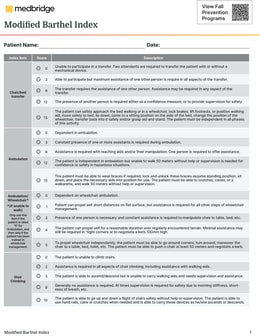Modified Barthel Index: Scoring Tool and Clinical Applications
September 17, 2025
8 min. read

Why the modified Barthel Index still matters
In rehabilitation and post-acute care, tracking daily function is central to admission decisions, plan-of-care goals, and discharge readiness. The Modified Barthel Index (MBI) gives clinicians a quick, validated way to measure independence with activities of daily living (ADLs), document progress over time, and align care plans with payer expectations.
Adapted from the original Barthel Index, the “modified” version widens score granularity, which helps capture meaningful gains that might be missed with coarser scales. This article reviews what the modified Barthel Index measures, how to score it, how to interpret the results, where to find a modified Barthel Index PDF, and how to use a Modified Barthel Index calculator. A brief case example shows how scores guide care planning.
What the modified Barthel Index measures
The modified Barthel Index totals performance across ten ADL domains to a 0–100 score, where higher scores reflect more independence.
Common domains include:1,2
Feeding
Bathing
Grooming
Dressing
Bowel control
Bladder control
Toilet use
Transfers
Mobility
Stairs
Item anchors describe the level of assistance required—from dependent to independent with or without aids—so the score reflects what a person actually does in daily life.1,2
Why a “modified” version? The original instrument from the 1960s remains foundational, yet it can be less sensitive to change at higher function levels. MBI variants use expanded point increments and refined descriptors to pick up smaller but important gains—particularly valuable in home health, stroke rehabilitation, and geriatric care. Validity and reliability have been supported across multiple studies and populations.2,3
Modified Barthel Index PDF

How to administer and score the MBI in practice
The modified Barthel Index is straightforward to use, but consistent administration is key to reliable results. Think of the process in four steps: gathering information, scoring items, interpreting totals, and timing assessments.
Information sources
Use direct observation, patient interview, and caregiver report as needed. Follow standardized instructions to keep scoring consistent across clinicians and visits. Always record what the patient actually does—not what they could do under ideal conditions.1
Item scoring
Each ADL domain is rated based on how much assistance the patient requires. Anchors typically include categories such as independent, needs some help, or dependent. Modified versions expand these options (using scales like 0/5/10 scoring) to provide finer detail. Add up the 10 item scores for a total out of 100.1,4
Interpreting totals
Cut-points provide a quick snapshot of functional dependence:
0–20: total dependence
21–60: severe dependence
61–90: moderate dependence
91–99: slight dependence
100: independent
Pair these bands with narrative notes on safety, caregiver support, and equipment needs for a more complete clinical picture.2,3
Administration time and frequency
Most clinicians complete the MBI in just 5 to 10 minutes, making it practical for bedside, home health, or clinic use. Incorporate it at the start of care, during key reassessments, at transitions, and at discharge to track measurable progress and support outcome reporting. Regular use across these time points helps align documentation with both clinical goals and payer expectations.1-3
Example: Using the modified Barthel Index in Home Health
A 76-year-old returns home after hospitalization for pneumonia and deconditioning. As part of the admission assessment in home health, the clinician administers the modified Barthel Index to document baseline ADL performance and guide care planning.
Scoring snapshot
Feeding - 10
Grooming - 10
Bathing - 5
Dressing - 5
Bowel - 10
Bladder - 10
Toilet use - 5
Transfers - 5
Mobility - 5
Stairs - 0
Total: 65
How to interpret this score
A total of 65 indicates moderate dependence. The patient is largely independent with self-care but requires hands-on help for transfers, mobility, and stairs—tasks that strongly impact safety and caregiver burden.
Care planning
The primary goal was to improve transfers and mobility safety, with the expectation of raising the MBI score to at least 85 within six weeks.
Interventions included:
ADL retraining with energy conservation strategies
Progressive strengthening and balance training
Caregiver education on safe assists and equipment use
Stair practice with pacing and handrail support
Progress notes tied ADL performance directly to patient safety and caregiver burden, while the MBI score provided objective evidence to support therapy frequency, justify equipment recommendations, and demonstrate discharge readiness.
Reassessment at week four
With progressive therapy and a structured home exercise program, the patient improves to an MBI score of 85 (slight dependence). This reflects independence in most ADLs with minimal assistance for complex mobility. The team reduces visit frequency and prepares for discharge, coordinating community resources for long-term support.
MBI cut-scores make it easy to demonstrate progress, connect interventions to outcomes, and communicate improvements in safety and caregiver load.
Benefits and limits to keep in mind
The MBI offers clear advantages for daily practice, but like any tool, it has boundaries clinicians should recognize.
Strengths
Brief and practical. Easy to complete at the bedside, in the clinic, or at home, and integrates well with electronic documentation.1
Sensitive to change. Expanded scoring captures subtle but important functional gains across a plan of care.2,3
ADL-focused outcomes. Directly reflects daily tasks that impact safety, caregiver effort, and independence.1,2
Limitations
Not a cognitive screen. Use additional tools for cognition, mood, or communication when these factors affect daily function.
Inter-rater variability. Calibration and shared scoring anchors help teams maintain reliability.1
No IADLs. Instrumental activities of daily living—such as shopping, medication management, or managing finances—require separate measures.
Cut-scores, goals, and reporting
The modified Barthel index anchors a tidy narrative for goals and outcomes:
Set targets using bands
Cut-score ranges make it easy to frame realistic goals. For example, you might aim for a shift from moderate to slight dependence within six weeks by focusing on transfers and stair navigation. These bands also give patients and families a concrete way to see progress.2,3
Connect to safety and participation
Item-level changes highlight how gains translate into daily life. Improved toileting, transfers, or stair use, for instance, can reduce fall risk, ease caregiver load, and allow greater independence at home. Linking these tasks to participation gives your care plan more impact in both clinical and payer discussions.
Show measurable progress
Document start-of-care and reassessment totals, then call out item-level changes that reflect functional improvements.2,3 This combination demonstrates that therapy is both effective and patient-centered.
When reporting, pair the numeric score with narrative notes about devices, cues, fatigue, or time to complete tasks. These details provide critical context for teams, payers, and caregivers, ensuring the score reflects real-world function.
Modified Barthel Index PDF and calculator
Many clinicians prefer a printable modified Barthel Index PDF for bedside or field use, along with a digital calculator for faster totals. One widely used option is the modified Barthel short form (PDF), a handy one-page sheet for quick paper scoring.
In addition to convenience, using a standardized PDF or calculator helps maintain accuracy across different settings—whether at the bedside, in home health, or during community-based visits. Consistent access to the same version of the tool also supports team calibration and strengthens the reliability of outcome data.
Best practices for the modified Barthel Index
To get the most value from the modified Barthel Index, focus on consistency and integration into your workflow:
Standardize scoring anchors. Use a one-page reference card or laminated sheet so every clinician applies the same criteria. This reduces variability and speeds up onboarding for new staff.
Pair with mobility and fall measures. Tools such as the timed up and go (TUG) test, gait speed, or the Tinetti balance test complement the MBI when mobility is a key driver of outcomes.
Integrate into your EHR or digital platform. Built-In calculators minimize arithmetic errors and preserve item-level details for audit trails and reporting.
Use at consistent time points. Administer the MBI on admission, at recertification, during transitions, and at discharge. This makes outcomes easier to compare across patients and caseloads.
By pairing the modified Barthel Index with targeted fall-risk screening, your team can identify ADL barriers linked to near-falls and injuries—especially with transfers, toileting, and stairs—and then set measurable goals with the right interventions.
Medbridge’s Fall Prevention solution brings together screening workflows, clinician training, exercise progressions, patient education, and outcomes tracking to support consistent practice and clearer documentation.
From scoring to better outcomes
The modified Barthel Index provides clinicians with a quick, reliable way to measure independence in daily activities while supporting clear documentation and care planning. Its sensitivity to change makes it especially useful for demonstrating progress during rehabilitation.
When integrated into routine practice and paired with complementary measures, the MBI offers a practical framework for aligning patient goals with clinical outcomes. It helps teams track recovery, communicate more effectively with payers, and ultimately improve patient safety and independence.
References
Alberta Health Services. (2015, April). Barthel Index of Activities of Daily Living. Bone & Joint Health Strategic Clinical Network. https://www.albertahealthservices.ca/assets/about/scn/ahs-scn-bjh-hf-barthel-index-of-adls.pdf
Ohura, T., Hase, K., Nakajima, Y., & Nakayama, T. (2017). Validity and reliability of a performance evaluation tool based on the modified Barthel Index for stroke patients. BMC medical research methodology, 17(1), 131. https://pubmed.ncbi.nlm.nih.gov/28841846/
Lee, S. Y., Kim, D. Y., Sohn, M. K., Lee, J., Lee, S. G., Shin, Y. I., Kim, S. Y., Oh, G. J., Lee, Y. H., Lee, Y. S., Joo, M. C., Lee, S. Y., Ahn, J., Chang, W. H., Choi, J. Y., Kang, S. H., Kim, I. Y., Han, J., & Kim, Y. H. (2020). Determining the cut-off score for the Modified Barthel Index and the Modified Rankin Scale for assessment of functional independence and residual disability after stroke. PloS one, 15(1), e0226324. https://pmc.ncbi.nlm.nih.gov/articles/PMC6988933/
